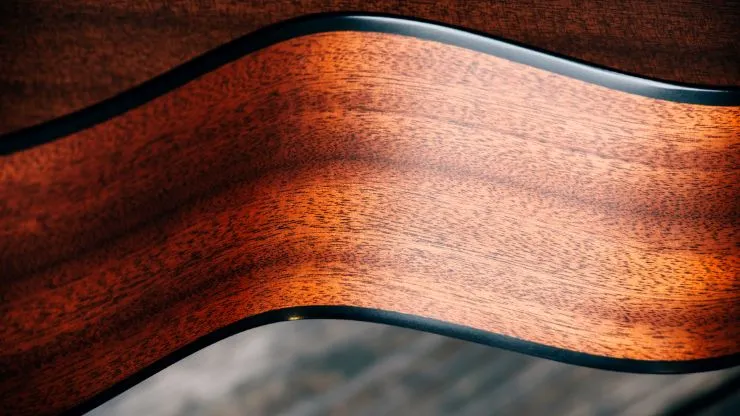What Is Sapele?
Entandrophragma cylindricum, or sapele as it is more commonly known, is a tree native to Central Africa. It takes its name from the city of Sapele in Nigeria and is a relatively tall and slow-growing hardwood species. Following the addition of genuine mahogany to the CITES international agreement, sapele has entered the picture as a more sustainable alternative. It has a variety of applications, including flooring, furniture, veneers, boat construction, and musical instruments.
Why Is Sapele Used for Guitars?
The old guard of classic tonewoods remains as popular as ever. However, it’s inescapable that woods such as ebony, mahogany, and rosewood aren’t available in the quantities they once were. These woods have helped define music over the years. But now, guitar makers are increasingly turning to alternatives that can pick up the mantle and shape the future of music. With many of the same characteristics as mahogany, sapele is the ideal substitute for numerous applications. Cheaper, stronger, and more readily available, sapele is sure to grow in popularity over the coming years.
How Is Sapele Used in Guitars?
Sapele is a popular tonewood choice for acoustic guitar bodies, where it may appear on the back, sides, and top. Its strength and stability make it a fine choice for guitar necks, although it’s a little too soft for fretboards.
Despite its similarities to mahogany, one of the most popular choices for solid body electric guitars, sapele solid body guitars are actually relatively uncommon. However, it makes for a perfectly valid, if not slightly heavy, option for such a purpose. Given that sapele is currently more sustainable than mahogany, more will likely be on the market in the future. At the moment, sapele is a little more frequently seen in hollow body models.
How Do Sapele Guitars Sound?
Sapele is commonly used as a substitute for mahogany, and with good reason. It possesses many of mahogany’s classic, well-balanced tonal qualities, including pleasant warmth, strong mids, clear lows, and great sustain. However, due to Sapele’s harder nature, it features slightly brighter highs than mahogany.
Are Sapele Guitars Durable?
With a score of 1,410 on the Janka Hardness Scale, sapele is significantly harder than mahogany, for instance. This hardness, together with its excellent water and wood rot resistance, means that sapele offers incredible durability.
Sapele Guitar Maintenance
Thanks to the wood’s fairly robust nature, maintenance of sapele guitars is a piece of cake, so long as you follow the standard guitar maintenance guidelines:
- Keep your guitar at a stable temperature and humidity.
- Clean it with a suitable, finish-appropriate guitar polish.
- Dust with a non-abrasive cloth (ideally microfiber).
- Store your guitar in a case when you aren’t jamming on it.
Is Sapele Sustainable?
Sapele entered the guitar world as an alternative to genuine mahogany, which is now regarded as vulnerable by the International Union for Conservation of Nature (IUCN). Therefore, it stands to reason that sapele is sustainable, which, as of now, is true – albeit with a caveat.
Sapele is currently widely available. However, due to a 20% reduction in population over the last three generations, it has also found itself a place on the IUCN Red List. This means there are already concerns about the possibility of species extinction should harvesting continue at current levels.
What Are the Pros and Cons of Sapele Guitars?
Some of the advantages of sapele tonewood include the following:
| Pros | Cons |
|---|---|
| Well-balanced tone | Heavy |
| Good mid-range performance | Brighter sounding than mahogany |
| Clear lows and bright highs | Relatively hard to work with |
| Strong and durable | |
| Cheaper than mahogany | |
| Attractive grain |
Is Sapele a Good Alternative to Mahogany?
Although sapele is a relative newcomer to the world of tonewoods, it has quickly become a popular option. Many big hitters in the guitar world have adopted the wood, including Taylor, Martin, Ibanez, and Fender - all glowing references to the wood’s qualities. Its sound isn’t for everybody; if rosewood is more your style, you’ll probably want to pass on sapele. But if you already dig mahogany guitars, then sapele could be right up your alley.
Is sapele better than mahogany? Well, that depends on your taste for treble. If you like mahogany but wish it was a little brighter, you’ll love sapele. But, if you adore the warmth and darkness of mahogany, then you might find sapele lacking. However, there’s a lot to love about sapele as a mahogany alternative: similar sound, cheaper, stronger, and more sustainable.
Sapele Tonewood Alternatives
The obvious first alternative to consider would be mahogany. While a little pricier, mahogany offers more warmth and impeccable sustain. For a more dynamic tone with incredible highs and lows, think about rosewood, or even ovangkol, a sustainable rosewood alternative with many of the same tonal characteristics. Finally, take a look at maple if you want a crisp sound with more emphasis on treble.
Finding Your Sapele Guitar
As a great alternative to mahogany, it looks like sapele is here to stay. More and more brands are adding sapele guitars to their ranges, but some excellent models are already available right now! Visit our Finder tool to hunt down your perfect sapele guitar.

